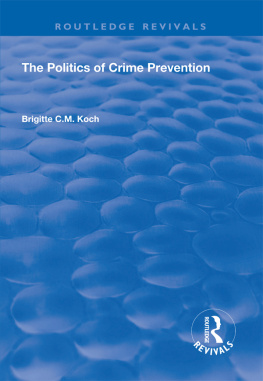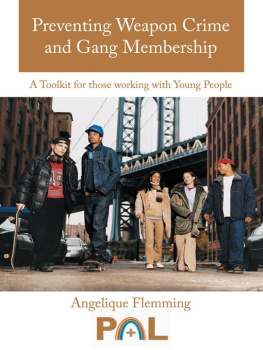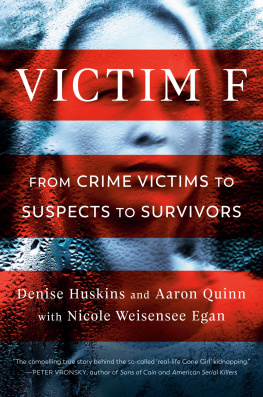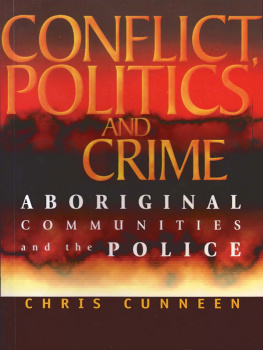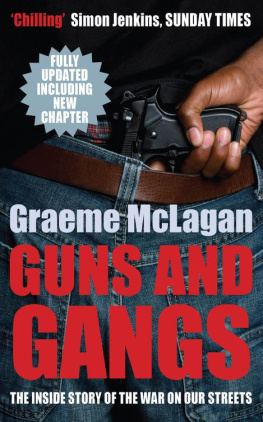First published 1994 by Ashgate Publishing
Published 2017 by Routledge
2 Park Square, Milton Park, Abingdon, Oxon OX14 4RN
711 Third Avenue, New York, NY 10017, USA
Routledge is an imprint of the Taylor & Francis Group, an informa business
Copyright Simon Anderson, Richard Kinsey, Ian Loader and Connie Smith 1994
All rights reserved. No part of this book may be reprinted or reproduced or utilised in any form or by any electronic, mechanical, or other means, now known or hereafter invented, including photocopying and recording, or in any information storage or retrieval system, without permission in writing from the publishers.
Notice:
Product or corporate names may be trademarks or registered trademarks, and are used only for identification and explanation without intent to infringe.
British Library Cataloguing in Publication Data
Anderson, Simon
Cautionary Tales: Young People, Crime and Policing in Edinburgh I. Title
364.36094134
ISBN 1 85628 851 X
Library of Congress Cataloging-in-Publication Data
Cautionary tales: young people, crime and policing in Edinburgh / Simon Anderson ... [et al.] p. cm.
Includes bibliographical references.
ISBN 1-85628-851-X : $55.95 (est.)
1.Juvenile delinquencyScotland-Edinburgh. 2. Youth
ScotlandEdinburghSocial conditions. 3. Victims of crime Scotland-Edinburgh. 4. CrimeScotlandEdinburgh.
I. Anderson, Simon, 1965- .
HV9147.E35C38 1994
364.3'6'094134-dc20 94-18854
CIP
ISBN 13: 978-1-85628-851-4 (hbk)
Contents
List of Figures
List of tables
Acknowledgements
Foreword
Preface
CHAPTER 1
CHAPTER 2
CHAPTER 3
CHAPTER 4
CHAPTER 5
CHAPTER 1
CHAPTER 2
CHAPTER 3
CHAPTER 4
CHAPTER 5
From the time of its inception back in the summer of 1988 this project benefited from the assistance of a great many people. First and foremost our thanks go to Lothian Regional Council for commissioning the research in the first place. Particular thanks in this regard are due to Councillors Paul Nolan, Elizabeth Maginnis and former Councillor Annette Lamont, and to Russell Forrest in the Education Department. Equally importantly, we must thank the headteachers of the schools for allowing us access, and the teachers who both tolerated our presence and ensured the research progressed smoothly and enjoyably.
In addition, our thanks go to Caroline Grove Smith and Jeremy Wood for their work on both the survey and interviews. We also owe an immense debt of gratitude to Toby Morris, Christine Reece, Frances Proven and Gillian Kirkwood at the University of Edinburgh Computing Service for their unstinting help when the computers baffled us. We are also grateful to Ian Dunn for sharing with us his encyclopaedic knowledge of Edinburgh and its history, and to Ed Smith for his enthusiasm. Thanks also to members of the Centre for Criminology and the Social and Philosophical Study of Law at the University of Edinburgh and to all those people who have commented on our work during the various seminars we have given in the last couple of years.
Finally, of course, our thanks are due to the young people who completed the survey and took part in the interviews.
We gratefully acknowledge the permission of Hutchinson and Co (Publishers) Ltd to reproduce material from Cliff Hagues (1984) The Development of Planning Thought, and of Penguin Books Ltd to reproduce material from Phillippe Aries (1962) Centuries of Childhood.
Throughout its history, British criminologys curiosity with regard to the young has almost exclusively been restricted to the identification and correction of the young male delinquent. In this respect, of course, criminology has faithfully reflected the equally narrow interests of the culture; in Britain - this old and settled society - young people seem ever and always to have been a source of anxiety and trouble. They are - as Stanley Cohen (1972) pointed out some time ago - a metaphor for social change - and often, especially when new youth cultural styles have begun to emerge, an angry metaphor for changes which that comfortable, socially powerful and adult fraction of English society had generally not wanted or even positively resented.
At several points during the late nineteenth and twentieth centuries groups of young men have been constructed as the feared Other in society, viewed as symbols of a breakdown of community and trust, or even, in some accounts, as the source of such a breakdown. In the post-war period, a never-ending sequence of youthful folk-devils (teddy boys, mods and rockers, skinheads, football hooligans) have been paraded through the media and the popular imagination.
In the meantime, official criminologys cold and formal models of delinquency have come to be mirrored in fictional accounts - for example, in the novels of disenchanted emigres like Anthony Burgess in the Clockwork Orange and William Golding in The Lord of the Flies - as well as in the continuing shock and horror stories of the popular press about gangs and yobbos on the street. There is a strong sense of a society - or at least a network of fictions writers, journalists and academic commentators - that really does not like young people very much, especially when they are the offspring of the lower orders.
The contrast, as so often in matters criminological, is with the United States. For all that America has always had a higher rate of crime than Britain, especially among the young, it has also consistently generated what we might call a sympathetic literature on the strains of adolescence and youth. Writers like Kenneth Kenniston (1960), David Matza (1964) and Alvin Schoor (1971) have all endeavoured to conceptualise the subjective processes associated with the transition to adulthood in America, and tried to understand the circumstances that may lead to a drift into sporadic or committed delinquency. In 1956, at the height of the Cold War, Paul Goodman had the courage to give voice, in Growing Up Absurd, to the fears and anxieties which he believed to be common among all young people: that the pains of growing up could and should be eased by a sense that the adult world might be a worthwhile one, a target worth aiming for both at school and in ones own personal life. At the time, of course, the most widespread concern among young people focused on the arms race and its potential consequences, but there was also an anxiety, which Goodman shared, that the world of employment - especially as driven by the giant corporations of the American economy - demanded from the young an unhealthy level of conformity to authority. Much of the youth trouble of the 1950s was seen as an entirely explicable expression of the rebelliousness of the young against the stultifying demands of the adult work-world of late fifties America.
But at least there was a world of work, with considerable security of tenure and comfortable salaries. The world that confronts young people in the 1990s, especially in the less competitive economies of the new global economic order (such as Britain) looks very different indeed. High levels of unemployment have continued throughout the 1980s and 1990s, with heavy concentrations of long-term joblessness in particular areas of our larger cities. Thousands of young people in the last 15 years have faithfully submitted themselves to what one commentator has called the magic roundabout of job-training schemes of one kind or another, only to have their hopes of real work continually smashed and their transition to full financial independence either delayed or indefinitely suspended. Unknown numbers of young people and young adults in the most benighted parts of our cities see the only opportunity for an income, and for access to the continuing enticements of the consumer society, as being the illegitimate economy of property crime and the drugs trade. But even for children and young people in more privileged areas, a world in which political leaders can only conjure up hope by reference to the ever elusive green shoots of recovery, and where economists now speak of a prospect jobless growth, is a very frightening prospect.


